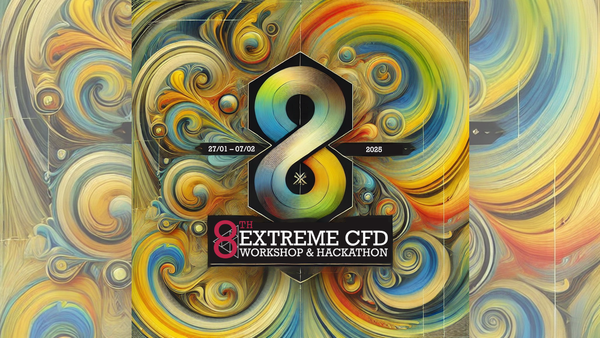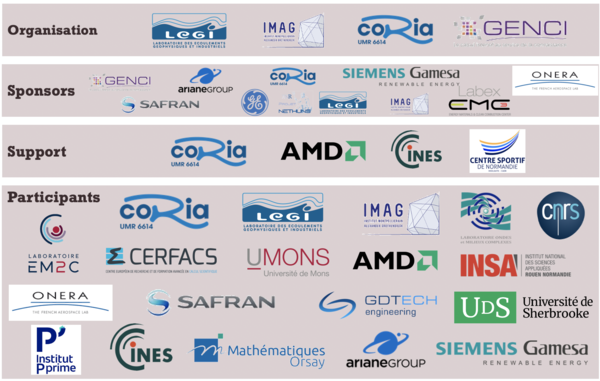ECFD workshop, 8th edition, 2025
Contents
- 1 Description
- 2 News
- 3 Thematics / Mini-workshops
- 4 Projects
- 4.1 Hackathon GENCI - P. Begou, LEGI
- 4.1.1 H1 - ParaDIGM and SONICS on GPU, B. Maugars, G. Staffelbach, R.Cazealbou and B. Michel (ONERA)
- 4.1.2 H2 - AVBP GPU offloading based on OpenMP, M.Ghenai, L. Legaux and A. Dauptain (CERFACS)
- 4.1.3 H3 - YALES2 GPU from OpenACC to OpenMP, P. Bégou (LEGI), V. Moureau, G. Lartigue (CORIA) and R. Dubois (IMAG)
- 4.2 Mesh adaptation - A. Grenouilloux, ONERA & G. Balarac, LEGI
- 4.3 Numerics - M. Bernard, LEGI & G. Lartigue, CORIA
- 4.4 Turbulence - L. Voivenel, CORIA & P. Bénard, CORIA
- 4.5 Two Phase Flow - J. Leparoux, SAFRAN & J. Carmona, CORIA
- 4.5.1 TP1 - Towards very small contact angles in Nucleate boiling
- 4.5.2 TP2 - Modeling spray-film interactions
- 4.5.3 TP3 - High-fidelity two-phase flow simulations of the purge of a fuel feed line
- 4.5.4 TP4 - Volume of Fluid solver in YALES2
- 4.5.5 TP5 - Implement a local operator to distribute the solid volume of a particle over multiple cells
- 4.5.6 TP6 - Complex thermodynamics in sloshing tanks
- 4.6 Combustion - Y. Bechane, CORIA & S. Dillon, SAFRAN & K. Bioche, CORIA
- 4.6.1 C1 - LES of the thermal degradation of a composite material
- 4.6.2 C2 - Flame stabilization by NRP plasma discharge
- 4.6.3 C3 - Extending and validating a generalized formalism of virtual chemistry
- 4.6.4 C4 - Turbulent combustion model for NOx prediction
- 4.6.5 C5 - Towards 3D simulation of detonation combustion
- 4.6.6 C6 - Flame stabilitity of flame-holders within reheat conditions
- 4.6.7 C7 - Thermal radiation in oxyflames
- 4.6.8 C8 - A first step toward hybrid CPU / GPU for reactive flow in YALES2
- 4.6.9 C9 - Soots numerical modeling
- 4.6.10 C10 - TECERACT : Tabulated chemistry generator for aeronautical combustion
- 4.6.11 C11 - Exploring efficient tabulation strategies for detailed chemistry
- 4.6.12 C12 - Dynamic sub-grid-scale modelling of multi-regime flame wrinkling
- 4.6.13 C13 - LES of a semi-industrial burner using a non-adiabatic virtual chemical scheme
- 4.7 User Experience & Data - L. Korzeczek, GDTECH
- 4.1 Hackathon GENCI - P. Begou, LEGI
Description
- Event from 27th of January to 7th of February 2025
- Location: Centre Sportif de Normandie, Houlgate, near Caen (14)
- Two types of sessions:
- common technical presentations: roadmaps, specific points
- mini-workshops. Potential workshops are listed below
- Free of charge
- Participants from academics, HPC center/experts and industry are welcome
- The number of participants is limited to 68.
- Objectives
- Bring together experts in high-performance computing, applied mathematics and multi-physics CFDs
- Identify the technological barriers of exaflopic CFD via numerical experiments
- Identify industrial needs and challenges in high-performance computing
- Propose action plans to add to the development roadmaps of the CFD codes
- Organizers
- Guillaume Balarac (LEGI), Simon Mendez (IMAG), Pierre Bénard, Vincent Moureau, Léa Voivenel (CORIA).
News
- 23/10/2024: First announcement of the 8th Extreme CFD Workshop & Hackathon !
- 22/11/2024: Deadline to submit your project
Thematics / Mini-workshops
These mini-workshops may change and cover more or less topics. This page will be adapted according to your feedback.
To come...
Projects
Hackathon GENCI - P. Begou, LEGI
This ECFD8 GENCI Hackathon was a rich event, involving 4 differents CFD codes (AVBP, ParaDIGM, SONICS and YALES2) using various paradygms (C++/cuda/hip, Fortran/OpenMP/OpenACC) with several SDKs (AMD, Cray/HPE, Nvidia, Gnu) on a large range of GPU architectures (Nvidia A100, GH100, AMD instinct Mi210, Mi250, Mi300). This two-week event benefited from a high level support from three HPC mentors, two on-site from AMD (J. Noudohouenou and A. Tsetoglou) and one remote from CINES (M. Boudaoud).
H1 - ParaDIGM and SONICS on GPU, B. Maugars, G. Staffelbach, R.Cazealbou and B. Michel (ONERA)
H2 - AVBP GPU offloading based on OpenMP, M.Ghenai, L. Legaux and A. Dauptain (CERFACS)
H3 - YALES2 GPU from OpenACC to OpenMP, P. Bégou (LEGI), V. Moureau, G. Lartigue (CORIA) and R. Dubois (IMAG)
Mesh adaptation - A. Grenouilloux, ONERA & G. Balarac, LEGI
Numerics - M. Bernard, LEGI & G. Lartigue, CORIA
N7 -Implicit time advancement for low-Reynolds number flows with particles. S. Mendez, C. Raveleau (IMAG), M. El Moatamid, V. Moureau (CORIA)
IMAG runs numerous simulations of red blood cells under flow. Those simulations are at low Reynolds number (0.001 to 1.0, typically). Splitting of the time advancement is used to treat the diffusion terms implicitly, albeit with an important numerical cost: implicit diffusion is 50 to 60% of the computational cost. Recently, M. El Moatamid implemented a genral framework to deal with implicit time advancement for scalars. In this project, the general method has been transposed to the advancement of the velocity field in the ICS and RBC solvers of YALES2/YALES2BIO. This enables testing various linear solvers (GMRES based). However, such solvers do not decrease the CPU time compared to the existing implementation. However, while working on this, it was identified that residual recycling was not activated in the current implementation of the implicit diffusion. This sped up the implicit diffusion cost by 35%, for a total gain of 20% for the computation. In addition to this achievement, moving to the framework coded by Moncef will have other beneficial side effects: we anticipate simplifying the implementation, with an easier merging between YALES2BIO and YALES2. The method will also be implemented in the electrosatic solver, for which the Poisson problem should benefit from the new GMRES-based solvers. In addition, this project highlights the importance of improving the treatment of stiff source terms in the red blood cells simulations, to be able to overcome the current limitation in time step due to those term and have a chance to benefit from higher-order time schemes, efficient at high Fourier numbers.
Turbulence - L. Voivenel, CORIA & P. Bénard, CORIA
T1 - FSI-1D strategy for internal flows
T2 - Dynamic Smagorinsky in Dorothy
T3 - Turbulence injection strategy for compressible flows
T4 - Improve wind farm workflow
T5 - Improve atmospheric inflow turbulence
Atmospheric inflow turbulence is generated using the precursor database method. A half-channel flow driven by a pressure gradient is used to obtain the inflow which is used as inlet boundary condition for the wind turbine simulation domain. This project aimed to improve the whole methodology, from generation to injection.
- WP1: Improve inflow generation
Anand: pressure controller
- WP2: Improve injection methodology (method A)
The previous workflow used plane probes in the ASCII format to sample the flow. The COWIT2 toolbox was used to convert the file into turbulence box (.man format). While functioning, this methodology had two major flaws. First the probe files are heavy ~O(10Go). Second, the method requires a lot of human effort, allowing numerous sources of errors. During this workshop, a new methodology has been developed. First, the probes are generated using the HDF5 format (now available for all probe types), leading to lighter file ~O(1Go). Second, Y2_tools is used to read HDF5 format (working for probes and temporals). HDF5 file is then converted into a Look-up Table. Finally, the Look-up Table is read directly by YALES2 as a boundary conditions.
- WP3: Improve injection methodology (method B)
Even though improvements achieved in WP2 prove to be very handy while removing many potential human errors, injecting a turbulent inflow through wind boxes ('offline' precursor approach) can sometimes remain cumbersome for several reasons: (1) no periodicity is enforced in the streamwise direction of those boxes, (2) potential high memory consumption, and (3) the boxes need to be moved to other cores whenever a mesh adaptation occurs. An alternative consists in co-simulating the precursor flow and the flow of interest (refered as the 'successor' simulation) at the same time ('online' precursor approach). The inlet boundary condition for the successor flow is then obtained by mapping the outflow of the precursor domain. During the workshop, some work has been initiated to implement this kind of coupling using the CWIPI library, for which YALES2 provides already an interface.
T6 - FSI model in Dorothy
Two Phase Flow - J. Leparoux, SAFRAN & J. Carmona, CORIA
TP1 - Towards very small contact angles in Nucleate boiling
Participants: Henri Lam (LEGI), Mohammad Umair (LEGI), Manuel Bernard (LEGI), Robin Barbera (LEGI) and Giovanni Ghigliotti (LPSC)
TP2 - Modeling spray-film interactions
Participants: Nicolas Gasnier (EM2C-SafranTech), Julien Leparoux (SafranTech), Mehdi Helal (CORIA-SafranTech) and Julien Carmona (CORIA)
TP3 - High-fidelity two-phase flow simulations of the purge of a fuel feed line
Participants: Thomas LAROCHE (Safran HE), Romain JANODET (Safran AE), Julien Leparoux (Safran Tech) and Melody Cailler (Safran Tech)
TP4 - Volume of Fluid solver in YALES2
Participants: Léa Voivenel (CORIA), Julien Carmona (CORIA), Mehdi Helal (CORIA), Pierre Portais (CORIA), Julien Leparoux (Safran Tech), Mélody Cailler (Safran Tech) and Nicolas Gasnier (EM2C / Safran Tech)
TP5 - Implement a local operator to distribute the solid volume of a particle over multiple cells
Participants: Théo Ndereyimana (Université de Sherbrooke), Stéphane Moreau (Université de Sherbrooke)
TP6 - Complex thermodynamics in sloshing tanks
Participants: C. Merlin (AGS), D. Fouquet (CORIA), V. Moureau (CORIA), J. Carmona (CORIA) and G. Lartigue (CORIA)

